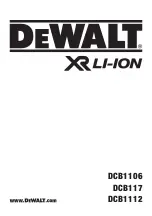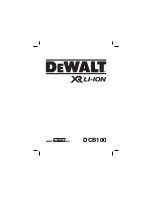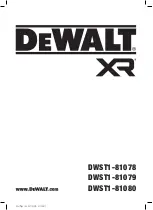
IMPORTANT SAFETY INSTRUCTIONS
FOR BATTERY CHARGERS
-SAVE THESE INSTRUCTIONS-
This manual contains important safety instructions for battery chargers.
• Before using charger, read all instructions and cautionary markings on charger, battery pack, and product using battery pack.
READ ALL INSTRUCTIONS
WARNING:
Shock hazard.
Do not allow any liquid to get inside charger. Do not freeze or immerse charger in water or any other liquid.
CAUTION:
Burn hazard.
To reduce the risk of injury, charge only designated
Black & Decker
LI-ION batteries. Other types of batteries may burst causing personal injury and damage.
CAUTION:
Under certain conditions, with the charger plugged into the power supply, the charger can be shorted by foreign material. Foreign materials of a conductive nature such as,
but not limited to, steel wool, aluminum foil, or any buildup of metallic particles should be kept away from charger cavities. Always unplug the charger from the power supply when there is no
battery pack in the cavity. Unplug charger before attempting to clean.
WARNING:
To reduce the risk of injury, basic safety precautions should always be followed including:
•
DO NOT attempt to charge the battery pack with any chargers other than the ones in this manual.
The charger and battery pack are specifically designed to work together.
•
These chargers are not intended for any uses other than charging designated
Black & Decker
LI-ION
rechargeable batteries.
Any other uses may result in risk of fire, electric shock or
electrocution.
•
Do not expose charger to rain or snow.
•
Pull by plug rather than cord when disconnecting charger.
This will reduce risk of damage to electric plug and cord.
•
Make sure that cord is located so that it will not be stepped on, tripped over, or otherwise subjected to damage or stress.
•
Do not use an extension cord unless it is absolutely necessary.
Use of improper extension cord could result in risk of fire, electric shock, or electrocution.
•
An extension cord must have adequate wire size (AWG or American Wire Gauge) for safety.
The smaller the gauge
number of the wire, the greater the capacity of the cable, that is 16 gauge has more capacity than 18 gauge. When using
more than one extension to make up the total length, be sure each individual extension contains at least the minimum wire size.
•
Do not place any object on top of charger or place the charger on a soft surface that might block the ventilation slots and result in excessive internal heat. Place the
charger in a position away from any heat source.
The charger is ventilated through slots in the top and the bottom of the housing.
•
Do not mount charger on wall or permanently affix charger to any surface.
The charger is intended to use on a flat, stable surface (i.e., table top, bench top).
•
Do not operate charger with damaged cord or plug —
have them replaced immediately.
•
Do not operate charger if it has received a sharp blow, been dropped, or otherwise damaged in any way.
Take it to an authorized service center.
•
Do not disassemble charger;
take it to an authorized service center when service or repair is required. Incorrect reassembly may result in a risk of electric shock, electrocution or fire.
•
Disconnect the charger from the outlet before attempting any cleaning.
This will reduce the risk of electric shock. Removing the battery pack will not reduce this risk.
•
NEVER attempt to connect 2 chargers together.
•
The charger is designed to operate on standard household electrical power (120 Volts). Do not attempt to use it on any other voltage.
IMPORTANT SAFETY INSTRUCTIONS FOR BATTERY PACKS
WARNING:
To reduce the risk of injury, basic safety precautions should always be followed including:
•
Do not incinerate the battery pack even if it is severely damaged or is completely worn out.
The battery pack can explode in a fire. Toxic fumes and materials are created when
battery packs are burned.
•
Do not charge or use battery in explosive atmospheres, such as in the presence of flammable liquids, gases or dust.
Inserting or removing the battery from the charger may ignite
the dust or fumes.
•
If battery contents come into contact with the skin, immediately wash area with mild soap and water.
If battery liquid gets into the eye, rinse water over the open eye for 15 minutes
or until irritation ceases. If medical attention is needed, the battery electrolyte for Li-Ion batteries is composed of a mixture of liquid organic carbonates and lithium salts.
•
Contents of opened battery cells may cause respiratory irritation.
Provide fresh air. If symptoms persists, seek medical attention.
WARNING:
Burn hazard.
Battery liquid may be flammable if exposed to spark or flame.
• Charge the battery packs only in
Black & Decker
chargers.
•
Do not
splash or immerse in water or other
liquids.
This may cause premature cell failure.
•
Do not store or use the tool and battery pack in locations where the temperature may reach or exceed 105°F (40C˚) (such as outside sheds or metal buildings in summer).
WARNING:
Never attempt to open the battery pack for any reason. If battery pack case is cracked or damaged, do not insert into charger. Do not crush, drop or damage battery pack. Do
not use a battery pack or charger that has received a sharp blow, been dropped, run over or damaged in any way (i.e., pierced with a nail, hit with a hammer, stepped on). Damaged battery
packs should be returned to service center for recycling.
IMPORTANT CHARGING NOTE
Read manuals originally supplied with charger and tool before charging and using this battery. The batteries should be recharged when they fail or produce sufficient power on jobs which
were easily done previously. DO NOT CONTINUE to use the tool with its batteries in a depleted condition.
THE RBRC™ SEAL
The RBRC™ (Rechargeable Battery Recycling Corporation) Seal on the LI-ION battery (or battery pack) indicates that the costs to recycle the battery (or battery pack) at the end of its
useful life have already been paid by
Black & Decker
.
RBRC™ in cooperation with
Black & Decker
and other battery users, has established programs in the United States to facilitate the collection of spent LI-ION batteries. Help protect our
environment and conserve natural resources by returning the spent LI-ION battery to an authorized
Black & Decker
service center or to your local retailer for recycling. You may also contact
your local recycling center for information on where to drop off the spent battery.
RBRC™ is a registered trademark of the
Rechargeable Battery Recycling Corporation.
WARNING:
Fire hazard. Do not store or carry battery so that metal objects can contact exposed battery terminals.
For example, do not place battery in aprons, pockets, tool boxes,
product kit boxes, drawers, etc., with loose nails, screws, keys, etc.
Transporting batteries can possibly cause fires if the battery terminals inadvertently come in contact with conductive
materials such as keys, coins, hand tools and the like.
The US Department of Transportation Hazardous Material Regulations (HMR) actually prohibit transporting batteries in commerce or on
airplanes (i.e., packed in suitcases and carry-on luggage) UNLESS they are properly protected from short circuits. So when transporting individual batteries, make sure that the battery terminals
are protected and well insulated from materials that could contact them and cause a short circuit.
NOTE: Batteries should not be put in checked baggage.
CHARGING PROCEDURE
Black & Decker
chargers are designed to charge
Black & Decker
battery packs in 4-8 hours depending on the pack being charged.
1. Plug the charger into an appropriate outlet before inserting the battery pack.
2. Insert the battery pack into the charger.
3. The green LED will flash indicating that the battery is being charged.
4. The completion of charge is indicated by the green LED remaining on continuously. The pack is fully charged and may be used at this time or left on the charger.
Recharge
discharged batteries as soon as possible after use or battery life may be greatly diminished. For longest battery life, do not discharge batteries fully.
CHARGER DIAGNOSTICS
This charger is designed to detect certain problems that can arise with the battery packs or the power source. Problems are indicated by one LED flashing in different patterns.
Bad battery
The charger can detect a weak or damaged battery. The red LED flashes in the pattern indicated on the label. If you see this bad battery blink pattern, do not continue to charge the
battery. Return it to a service center or a collection site for recycling.
Hot/Cold pack delay
When the charger detects a battery that is excessively hot or excessively cold, it automatically starts a Hot/Cold Pack Delay, suspending charging until the battery has normalized.
After this happens, the charger automatically switches to the Pack Charging mode. This feature ensures maximum battery life. The red LED flashes in the pattern indicated on the
label.
Leaving the battery in the charger
The charger and battery pack can be left connected with the green LED glowing indefinitely. The charger will keep the battery pack fresh and fully charged.
Recommended Minimum Wire Size for Extension Cords
Total Length of Cord
25 ft.
50 ft. 75 ft.
100 ft. 125 ft. 150 ft. 175 ft.
7.6 m
15.2 m 22.9 m 30.5 m 38.1 m 45.7 m 53.3 m
Wire Size AWG
18
18
16
16
14
14
12
INSTRUCTION MANUAL
LI-ION Battery Charger
Catalog Numbers LCS12 12V MAX*,
LCS16 16V MAX*, LCS20 20V MAX*
*Maximum initial battery pack voltage (measured without a workload) is 12 volts. Measured under a workload, nominal voltage is 10.8.
*El máximo voltaje inicial del paquete de baterías (medido sin una carga de trabajo) es 12 voltios. Si se mide con una carga de trabajo, el voltaje nominal es 10,8.
*La tension initiale maximale du bloc-piles (mesurée sans charge de travail) est de 12 volts. La tension nominale, mesurée avec une charge de travail, est de 10,8 volts.
*Maximum initial battery pack voltage (measured without a workload) is 16 volts. Measured under a workload, nominal voltage is 14.4.
*El máximo voltaje inicial del paquete de baterías (medido sin una carga de trabajo) es 16 voltios. Si se mide con una carga de trabajo, el voltaje nominal es 14.4.
*La tension initiale maximale du bloc-piles (mesurée sans charge de travail) est de 16 volts. La tension nominale, mesurée avec une charge de travail, est de 14.4 volts.
*Maximum initial battery pack voltage (measured without a workload) is 20 volts. Measured under a workload, nominal voltage is 18.
*El máximo voltaje inicial del paquete de baterías (medido sin una carga de trabajo) es 20 voltios. Si se mide con una carga de trabajo, el voltaje nominal es 18.
*La tension initiale maximale du bloc-piles (mesurée sans charge de travail) est de 20 volts. La tension nominale, mesurée avec une charge de travail, est de 18 volts.






















